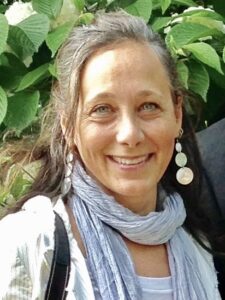
1. Can you tell us a little about your background and how you were first affected by/became aware of asylum seekers or displaced peoples?
For the past twenty-three years, I have worked as a clinical social worker/psychotherapist. My earlier work focused on children and adolescence living in group homes or residential treatment facilities. It was here that I first became acutely aware of the profound, negative impact that sudden separation from family and home has on the psyche. Over the years, in my private practice, I have worked extensively with trauma which always incorporates grieving over losses – loss of innocence, loss of a loved one, loss of one’s identity, country, faith, freedom, among many other losses. About 2015, I began to pay closer attention to the humanitarian crisis. Thousands of children and families were attempting to escape war-torn countries, trying to find sanctuary. A year or so later, I heard about a Swedish organization called Light House Relief who were organizing teams of skilled volunteers to provide humanitarian assistance. There was no question in my mind, I wanted to find a way to help. September of 2016, I flew to Greece and volunteered for a short time in the Children’s Safe Space at Ritsona Refugee Camp.
3. If you have worked with displaced people, can you tell us about a particular person, event or interaction that was most memorable?
When working at Ritsona, I volunteered with the children helping them with their psychosocial needs. There are many memories that are indelibly etched into my heart, but one has to do with a young child involved in an art project. The children’s bodies were traced on large rolls of paper. Then, they filled in the outlines with drawings and words representing how they felt about themselves.
This one young boy scribbled black crayon all over his outline, using so much force that he slashed through the paper. With tears streaking down his cheeks, he tore the paper apart into pieces, stuffed them into his mouth and attempted to swallow them. Witnessing this child’s anger, pain, and symbolic attempt to self-annihilate made a profound impression.
4. Can you tell us about any current projects upon which you are now working?
Since returning to the United States, I have been involved in a number of projects. In 2017, I participated on a panel for Art for Aleppo, a fundraising project delivering relief for Syria. Through this project, visual artists all over the world, including myself, created art that was later exhibited in a gallery. The proceeds of the art sales went to Save the Children and the Syrian Relief Fund. I also had an advocacy piece published in Witness Magazine regarding the plight of thousands of mentally ill people in Indonesia who are continuing to be at the mercy of an abusive practice called Pasung. Throughout the past two years I have had dozens of poems published in a variety of magazines and reviews linked to the refugee crisis.

Most recently, I organized an event linked to “One hundred Thousand Poets for Change.” I’m very excited about my newest project with a theater company who would like to create a staged performance of my poetry manuscript based on my impressions at the refugee camp.. Lastly, I’ll be curating a local art exhibit on Art and Activism.
5. In many countries, including the US, Australia, and UK there is often a stigma against and negative feeling toward refugees. What do you want people to know about refugees?
I believe fear creates stigma and negative feelings. Fear defines refugees as the “other”, and holding onto the concept of the “other” keeps people ignorant. Ultimately, we all want the same things – obviously, a safe place to call home, a job, education for our children, and above all, freedom.
6. How does it make you feel when people in the West characterize asylum-seekers, refugees and immigrants as dangerous, causing them to want to close their borders?
Enraged.
6. What is next for you?
Pablo Neruda said, “Poetry is an act of peace. Peace goes into the making of a poet as flour goes into the making of bread.” I believe that creative expression creates empathy and deeper connections. I will continue to write poetry, treat clients in my psychotherapy practice, begin collaboration on the theater production, and hopefully, do more humanitarian work.
Pact Press is proud to include Loretta Oleck’s poem ‘Laya & Aseel’ in our upcoming We Refugees anthology, a Regal House Initiative publication, the revenue from which will benefit the Asylum Seeker Resource Centre.

Loretta Oleck, 2016 Pushcart Poetry Prize nominee, is the author of two poetry collections, Songs from the Black Hole (Finishing Line Press), and Persephone Dreaming of Cherries (Hurricane Press). Her poetry and photography have been published in The Stockholm Review of Literature, The Adirondack Review, The Missing Slate, Obsidian Literature, Black Lawrence Press, So to Speak: Feminist Journal of Language and Art, Feminist Studies, Picayune Magazine, Poetica Literary Magazine, WordRiot, among numerous others. Her poetry was filmed for the Public Poetry Series, included in Storm Cycle’s Best of 2013 Anthology.